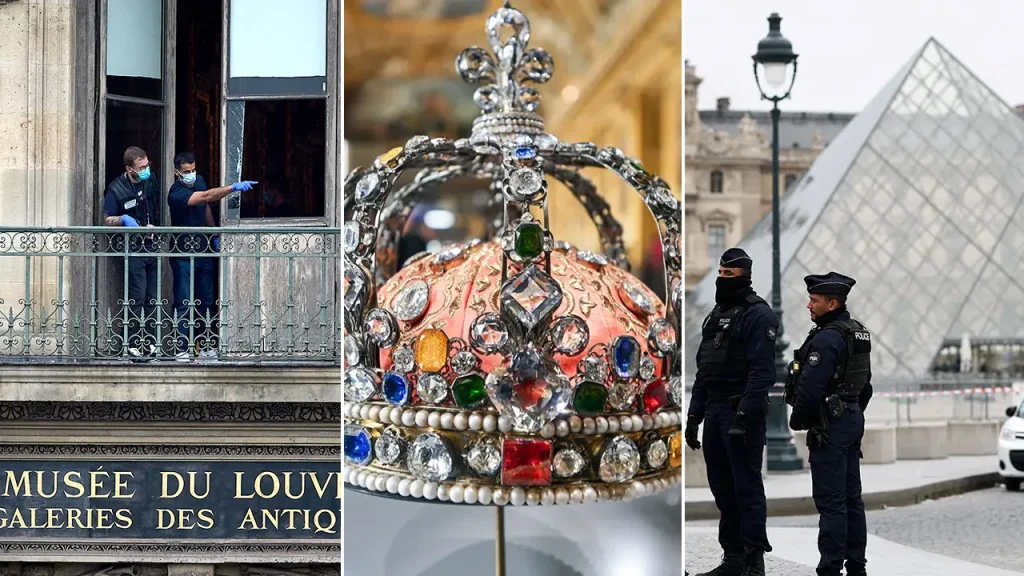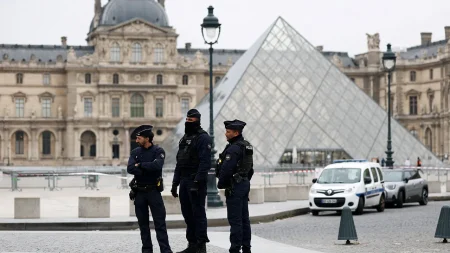The Louvre Heist: Organized Crime and the Mystery of Stolen Treasures
In a brazen act of theft that has shocked the art world, masked robbers disguised as construction workers executed a daring seven-minute heist at the Louvre Museum in Paris, making off with priceless jewelry in broad daylight. Paris prosecutor Laure Beccuau has suggested to local media that this wasn’t a random crime but potentially the work of organized criminals who may have been commissioned by a private collector. “We’re looking at the hypothesis of organized crime,” Beccuau told BFM TV, noting that these thieves demonstrated professional precision that suggests they either operated on behalf of a specific buyer or were motivated solely by the immense value of the jewels and precious metals they targeted. The investigation remains open to all possibilities, though foreign interference has largely been ruled out.
The speed and precision of the robbery have raised serious questions about security at the world’s most visited museum. According to reports, the thieves extended a basket lift to a window, smashed it open with an angle grinder, and used a disc cutter to slice through the protective glass displaying the jewels—all while visitors and staff were present during what’s described as one of the museum’s most chaotic periods. Former jewel thief Larry Lawton, who now assists police with such investigations, believes this “had to be an inside job” or that the thieves “had inside information.” He questioned how the robbers knew critical details like the thickness of the glass and the presence or absence of alarms. This level of preparation suggests meticulous planning rather than an opportunistic crime.
The thieves successfully targeted nine objects in the collection, managing to steal eight of them before making their escape on motorbikes. Interestingly, they failed to take what might have been the most valuable piece—the crown of Napoleon III’s wife, Empress Eugenie, which experts value at tens of millions of euros. The authorities have not yet identified the perpetrators, but the investigation continues to focus on how such a significant theft could occur in one of the world’s most secure museums. Following the incident, the Louvre announced its closure on Monday to assess security protocols and cooperate with investigators, signaling the seriousness with which officials are treating this breach.
If the thieves were indeed commissioned by a private collector, as Beccuau suggests, there might be a silver lining to this cultural tragedy. Stolen pieces acquired for private collections are typically well-preserved until recovered, since the collector’s interest lies in the objects’ artistic and historical value rather than their potential to be melted down or broken apart. However, if the thieves acted independently, the future of these treasures becomes more concerning. “Nowadays, anything can be linked to drug trafficking, given the significant sums of money obtained from drug trafficking,” Beccuau noted, suggesting the jewels could become pawns in money laundering operations if not secured by a collector who appreciates their cultural significance.
The path forward for these stolen treasures remains uncertain. Lawton, drawing on his own criminal past, offered insight into how the thieves might proceed: “I might put them and stash them somewhere no one knows, wait a year or two.” This strategy would allow time for the initial investigation to cool down before attempting to collect what Lawton believes would eventually become substantial rewards offered by insurance companies wanting the pieces returned “with no questions asked.” He suggested companies might offer up to a million dollars for the safe return of these historically significant items, as “obviously they want their jewels back.” This waiting game is common in high-profile art thefts, where immediate attempts to sell stolen goods would attract unwanted attention.
This incident joins an unfortunate list of museum thefts worldwide that have resulted in the loss or destruction of priceless cultural artifacts. The audacity of this particular crime—executed in one of the most famous and presumably secure museums in the world—raises troubling questions about the vulnerability of our shared cultural heritage. While investigators pursue all leads and the museum reviews its security measures, the art world watches anxiously, hoping for the recovery of these irreplaceable treasures. Whether motivated by greed, commissioned by collectors with dubious ethics, or part of larger criminal enterprises, such thefts represent not just financial losses but potential erasures of history that belong to all humanity. Until these pieces are recovered, their absence leaves a gap in the tapestry of human artistic achievement that the Louvre has long been entrusted to protect.














